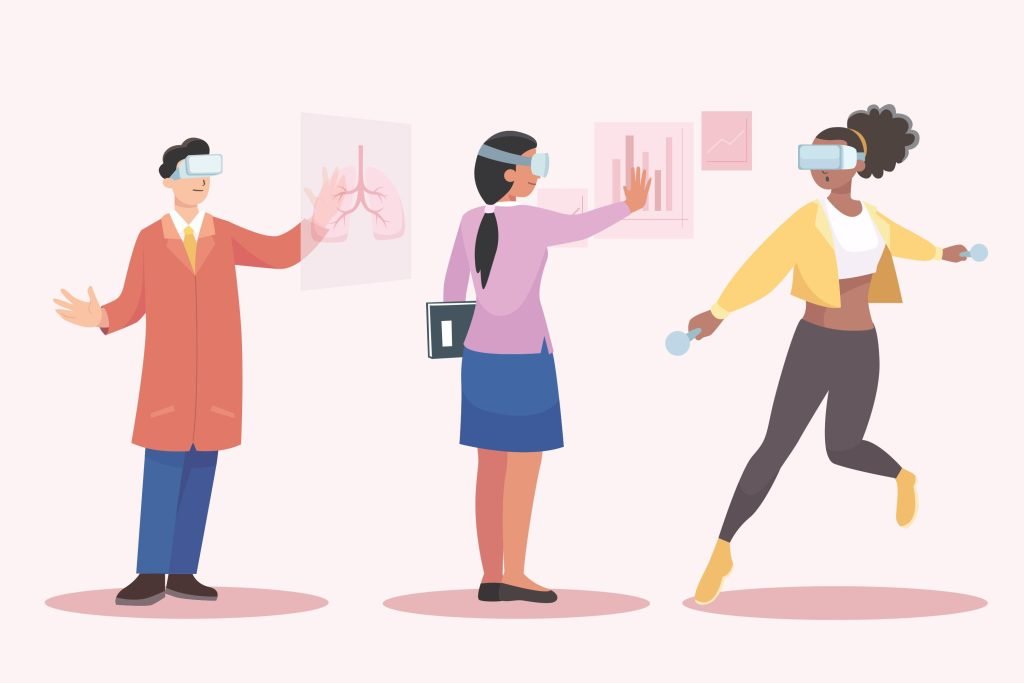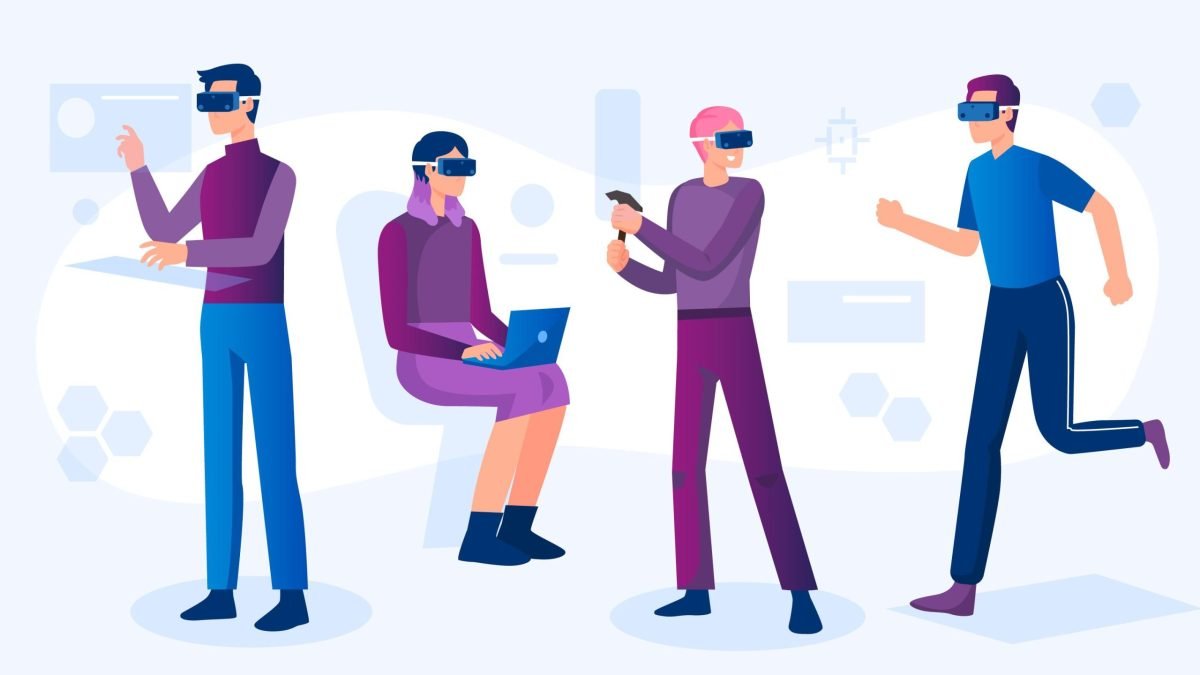Virtual Reality (VR) and Augmented Reality (AR) have been fascinating us for decades. They offer intense experiences that cross the line between the real and digital worlds. AR adds imaginary features to the real world, while VR makes completely fake worlds.
In the past few years, these technologies have made a lot of progress, which has changed many businesses and changed how we get information and pleasure. In this blog, we’ll talk about the future of virtual and augmented reality, looking at how they might affect different fields and the exciting things they could do.
YOU MAY ALSO LIKE: 8 amazing benefits of programmatic advertising services
Entertainment and Gaming
Virtual reality and augmented reality have already changed the entertainment and game businesses in big ways. VR games have changed from being easy to being very realistic and involved. With more advanced headgear and motion-tracking technologies, players can explore virtual worlds, take part in realistic exercises, and even work with other users in shared settings. The future of gaming looks like it will have more lifelike images, feedback that you can feel, and more complex social relationships. This will make games more fun than ever before.
AR is making new ways to tell stories and have engaging experiences in the entertainment world. With the success of mobile AR apps like Pokémon Go, we’ve gotten a taste of how AR could be used to make entertainment more fun. Imagine going to events where virtual objects and effects add to the live show or watching movies where the characters and scenes come to life in your living room. When AR and VR work together, it’s possible that entertainment will become even more engaging and interesting.
Education and Training
Virtual and augmented reality will change schooling and training in a big way in the future. VR can take students to different times and places in history, into the depths of the ocean, or on virtual field trips to faraway places. This interactive learning setting can make complicated topics much easier to understand and more fun to learn about.
AR, on the other hand, can be used to enhance actual learning tools by making them more engaging and adding information in real time. For example, medical students can practice surgery on virtual patients, and workers can get step-by-step video directions while fixing complicated machinery. Using VR and AR in education and training will help bridge the gap between theory and practice, giving students real skills and making it easier for them to remember what they have learned.
Healthcare and Medicine
Virtual and augmented reality could change the way nursing and science are done. In the field of surgery, VR lets doctors practice complicated processes in a virtual world, which improves medical accuracy and reduces risks. It also gives the chance for virtual surgery aid, where expert surgeons can help and work with local doctors in real time, even if they are in different places.
AR can help improve medical training by giving doctors live views of patient data while they are diagnosing and treating patients. It can put patient information, vital signs, and medical pictures right on top of what the doctor is seeing, making it easier to make decisions and speed up processing. AR can also help surgeons with complicated surgeries by putting directional signs and important information right in front of their eyes.
Architecture and Design
AR and VR are about to change the way building and design are done. With VR, architects and designers can make virtual tours of buildings and settings so that clients can see and interact with them before they are built. This makes it easier to talk to each other and work together, and it makes it less likely that expensive design changes will need to be made later.
AR is useful during the planning and building steps because it lets planners and builders add virtual elements to real places. AR improves speed and accuracy by letting people see how planned designs would look on a site that already exists and by helping building workers put things in the right place. It also lets people work together in real time because they can see and talk about design features in the setting of the real world.

Remote Work and Telepresence
Augmented and simulated reality can change how work is done online by creating virtual settings that are interesting and encourage people to work together. With VR, teams that are physically far apart can meet in virtual boardrooms, share digital materials, and feel like they are in the same place even though they are not. By putting people in different places in the real world, AR can make telepresence better. This makes the conversation flow better and be more interesting.
Tourism and Travel
VR and AR have the power to change the travel and tourist businesses in a big way. Virtual reality can give virtual views of places, so people who want to travel can experience and learn about different places without leaving their homes. AR can make traveling more fun by giving real-time information about places, historical sites, and other points of interest. This helps people understand and get more involved with what they are seeing.
Simulation and Prototyping
VR and AR are useful tools for modeling and testing in many fields. Virtual and augmented reality can provide safe places to try out new ideas, like trying new product designs or modeling dangerous situations for training reasons. This cuts costs, makes organizations more efficient, and lets them try out and improve their ideas before putting them into action.
Social Interactions and Virtual Communities
As virtual and augmented reality technologies improve, we can expect to see the rise of social sites that are more lively and engaging. Virtual reality lets people meet and talk to friends, family, and even strangers in virtual places, giving them a sense of being there and making them feel like they’re sharing an experience. AR can put social media feeds, messages, and characters on top of the real world. This makes daily exchanges more interesting and helps to build virtual communities.
Accessibility and Inclusivity
Virtual reality and augmented reality could make events more approachable and open to more people. VR can give people with movement issues virtual experiences that let them go places and do things they might not be able to do in real life. AR can help people with disabilities see and hear better in real time by giving them information about their surroundings and giving them help.
Advertising and Marketing
VR and AR have the potential to change how marketing and ads are done. Brands can make VR experiences that are so realistic that customers can interact with their goods and services in a virtual world. By putting digital content on real items or places, augmented reality (AR) can make marketing efforts more engaging and personal. This increases customer involvement and leads to more sales.
Mind and Body Wellness
Virtual and augmented reality can help keep your mind and body healthy by giving you engaging experiences that help you relax, deal with stress, and feel good about yourself. AR apps can offer guided meditation and awareness experiences in the real world, while VR apps can take people to peaceful and relaxing places. These tools can also be used in therapy and rehabilitation areas to help with mental health and physical healing.
Conclusion
Virtual and augmented reality will have a huge impact on many businesses and parts of our lives in the future. VR and AR technologies are changing everything from how people learn and have fun to how they get medical care and talk to each other. These technologies are pushing the limits of what people can do. As technology keeps getting better, it’s important to deal with problems like technological limits, social concerns, and user adoption if we want to get the most out of these engaging technologies. Virtual reality and augmented reality are going to change how we connect with the world around us.
YOU MAY ALSO LIKE: 6 effective online advertising strategies for 2022 and beyond
For more martech and AI-related articles, continue reading iTMunch!
Feature Image Source: Photo by freepik
Image 1 Source: freepik





